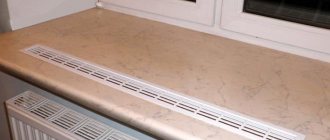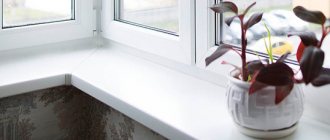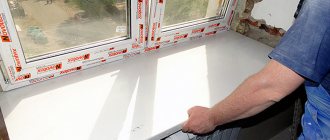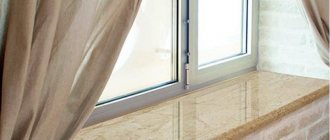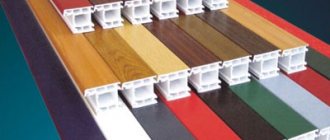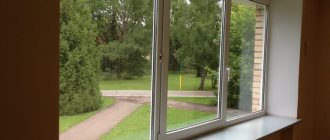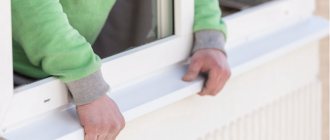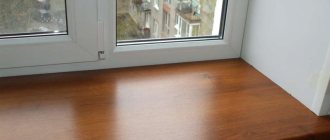The window market is one of the most developing sectors of the economy. According to ongoing research, most of it is occupied by the production and sale of plastic windows.
Along with the growing demand for windows, there is an increase in the sales of additional accessories: plastic window sills are gradually replacing analogues made of other materials from the market. Therefore, the production of PVC window sills is gaining increasing momentum in development, both in Europe and in Russia.
Content
- 1 Technology for the production of plastic window sills 1.1 Line for the production of plastic window sills
- 1.2 Quality of extruded PVC window sill
- 1.3 Lamination of PVC window sills
- 2.1 Fresh wood and nothing else
Production technology of plastic window sills
The technological process of manufacturing plastic window sills is called extrusion (from the Latin extrusio - pushing out). Extrusion is a method of manufacturing long-length profiled products from plastics and rubber. It consists of squeezing softened material through holes of a certain cross-section. The production line includes an extruder, tools (die, dry and wet calibration device), marking printer, pulling device, profile cutting saw, device for laying and packaging of finished products.
Plastic window sill production line
Source: from the site extruziya.ru
PVC, as the raw material for the manufacture of profiles, is supplied to production in the form of a fine white powder. It is mixed with other additives (stabilizers, softeners, polymer auxiliary reagents, fillers, plasticizers and, if necessary, pigments) until a homogeneous mixture is obtained and only then used to produce the final product. The choice of the appropriate additive in each specific case is determined by the technology of further processing and the requirements for the finished product. On the one hand, further processing of PVC is generally possible only if it contains additives; on the other hand, these additives affect the final properties of the finished PVC product. The material is loaded into the extruder hopper, fed into the loading window, from where it is captured by screws and moved along the heated cylinder. As it moves, the material is compacted, melts, goes into a viscous-fluid state, is homogenized and then passes through a forming tool, where it is formed into a product and calibrated, then cooled, captured by a pulling device, cut and entered into a receiving device.
Quality of extruded PVC window sill
depends on a number of interrelated factors, including: quality of raw materials (PVC resin); mixture recipe (ratio of components: resin and additives used); design features of the extruder; technological discipline, etc. Additives used in the production of PVC window sills include: stabilizers, sliding additives, modifiers, fillers, etc. Regarding stabilizers, it should be noted that lead-based stabilization is the most common today. Lead stabilizers are easier to process and are insoluble in water. However, in recent years they have been increasingly replaced by other types of stabilizers, primarily for environmental reasons. Often, however, arguments in favor of the latter are purely emotional. If we make an objective comparison of the two main types of stabilizers, we can say the following: if lead is the cheapest, partly toxic and characterized by a very high stabilizing effect, then calcium/zinc based stabilizers are not toxic, but less effective and more expensive. One of the most subtle technological issues in the extrusion of PVC window sills is fluctuations in the quality of raw materials in different supply batches, and even more so the transition to raw materials from another supplier. Currently, manufacturers of plastic window sills can obtain the necessary mixture in 3 ways: • purchase ready-made PVC compositions from third parties; • mix PVC resin with the so-called “all-in-one” compound, which contains all the necessary additives for stabilizing and processing PVC. • mix all the components of the mixture yourself. With method 2, the quality of the finished product can be changed within a fairly limited range, because The mixture recipe is determined by the ratio of only 2 components: PVC resin and compound. With the 3rd method, the quality of the finished product can be changed over a wider range, because The mixture recipe is determined by the ratio of all components. In this case, the quality of the mixture is largely determined by the qualifications and experience of chemist-technologists, who, depending on the quality of the feedstock, make decisions on the mixture recipe. To increase the efficiency of this process, standard recommendations are developed at the preparatory stage: for raw materials of various qualities, the optimal mixture recipe is determined experimentally for a specific extrusion line (the assessment is made according to the characteristics of the extruded PVC profile). As a result, they have a set of standard solutions for specific conditions. However, even with standard recommendations, you should constantly monitor the quality of the extruded PVC profile and, if necessary, adjust the mixture recipe. Essentially, the selection of a mixture recipe is carried out using the “trial and error” method, and the higher the qualifications and experience of chemical technologists, the less PVC waste in the process of switching to the feedstock from another supplier. The effectiveness of PVC as a structural material can only be realized through the use of a combination of appropriate additives, resulting in material properties that can meet stringent customer requirements.
Lamination of PVC window sills
Currently, two names for the process of applying film to a profile have become widespread: lamination (from the English verb to laminate) and lamination (from the German verb kaschieren). Both terms refer to the process of covering PVC moldings with decorative, weather-resistant films using special adhesives and laminating machines. Lamination of plastic window sills with decorative films is carried out using modern lamination installations, which make it possible to apply decorative film to any size window sill. The film has such important properties as strength, high resistance to atmospheric influences, as well as to ultraviolet rays, and retains its bright colors for a long time. The laminate reproduces the structure of wood - imitation of the texture of natural, light and dark oak, as well as mahogany, but other very diverse colors of acrylic films are also used. The lamination process occurs as follows: plastic window sills are heated to the desired temperature; covered with a layer of glue; By thermal activation, the film is glued to the profile using pressure rollers.
Werzalit window sills are made from a material called Werzalit (not to be confused with chipboard or MDF).
Werzalit material was invented and patented in 1956. Werzalit is a composite material produced by pressing from wood and duroplastic resins at high temperatures. Not only window sills are made from this material, but also countertops, facades and balcony railings.
Let's look at the production technology of Werzalit window sills in more detail.
Moeller
Moeller is a well-known German manufacturer of premium window sills. It is based on a Lingodur composition consisting of PVC and wood flour. The connecting element is hot melt adhesive used to create stable and strong panels. The finished material is environmentally friendly, does not contain toxic impurities and gives the window sill additional rigidity. Meller is considered the standard of quality. The wood-plastic mixture is covered with a layer of ELESGO acrylic, which makes the window sill scratch-resistant, moisture-resistant and easy to clean. Moeller window sills can support a weight of 400 kg. Service life – over 40 years.
The color palette of window sills is represented by natural shades of expensive wood species and marble imitations. The parameters of the window sill have an increased degree of strength:
- thickness – 18-22 mm;
- width – 100-800 mm;
- capinos height – 30 mm;
- PVC in the mixture is 70%.
The material is resistant to temperature changes and scratches, and also has original fittings. Meller window sills are not prone to fire, are not exposed to sunlight, are extremely durable and have a very attractive appearance. Price from price from 430 rub. per linear m.
Rice. 4. Characteristics of Moeller window sills
Fresh wood and nothing else
Only fresh wood grown in the immediate vicinity of the plant is used as raw material for the production of window sills. 69% - beech, 40% coniferous species. Only trees that have reached 100 years of age are used and no wood waste is used. Harvesting only fresh wood is an important component of uniform chip preparation and a precise mixture of hardwood and softwood. This is one of the components of the guarantee of stable quality and durability of a real Werzalit window sill.
Vitrage Plast
Vitrage Plast is a popular Russian manufacturer of window sills. Stained glass window Plast is made of high-quality PVC, with vertical internal stiffeners, giving the structure additional strength. Vitrazh Plast is characterized by the use of window sill boards with acrylic VPL coating. This acrylic-based protective and decorative coating consists of several layers of decorative paper, impregnation, base and top. VPL prevents the development of fungus, increases wear resistance and performs a protective function. The internal structure of Vitrage Plast consists of vertical stiffeners that protect the material from impacts, loads and pressure.
Vitrage VPL window sills have many advantages:
- contains no formaldehyde and lead;
- maximum moisture resistance;
- resistant to temperatures;
- not exposed to sun and chemicals;
- not prone to scratches.
Vintage Plast has a service life of up to 50 years. There are 2 categories of products available: Premium and Standard Vitrage. Available in several colors: white, mahogany, marble, golden oak. You can choose the shade of the coating from color films, where there are an additional 10 options. Price from price from 110 rub. per linear m.
Rice. 5. Premium and Standard Vitrage window sills
Pressing
The resulting mixture is fed into the press. Pressing takes place in two stages: 1-cold and 2-hot. Moreover, before hot pressing, a sandwich of decorative and protective films (up to 6 layers) is laid on the workpiece. This allows them to maintain absolute strength, color and meet hygienic requirements for a long time. Since immediately after the production of blanks, at temperatures above 160°C, the own adhesive ability of the resins of the base material and decorative material is activated. Unlike the simple gluing method, the resins adhere without a seam. Thus, the surface and the window sill material itself are fused. After hot pressing, excess films are cut off with special knives, and the window sill is sent to packaging. A distinctive feature of the technology for the production of Werzalit material from chipboard and MDF is that the formation of the board and the shaping and coating with decorative protective films occurs in one stage.
The article uses information from the website www.polymery.ru
Ten Leonid
Werzalit
Werzalit brand window sills belong to the premium segment and are considered one of the most reliable and environmentally friendly products in this category. Verzalit production is concentrated in Germany. The main material is extruded wood fibers and polymer. Finished window sills are monolithic, that is, they have no voids. This results in a more durable material with a homogeneous structure and increased resistance to moisture. Released in several series:
- Exclusiv – classic window sills with capinos, size 34 mm. Width from 100 to 600 mm.
- Compact - elegant designs with 18 mm capinos. Width from 100 to 450 mm.
- Ekhrona – elegant window sills with 34 mm capinos. Width from 100 to 600 mm.
- System is a functional window sill with an elongated spout. Kapinos can be from 65 to 140 mm, width from 100 to 600 mm.
The surface is covered with a film that protects the surface from fading, scratches and the influence of aggressive environments. The material is very strong, so it can withstand quite a lot of weight. The assortment includes 17 colors: stone, wood and uni decor. The material is heat-resistant and does not undergo deformation. The warranty period for Werzalit window sills is 25 years. Price from 1150 rub. per linear m.
Rice. 2. Werzalit window sill palette

